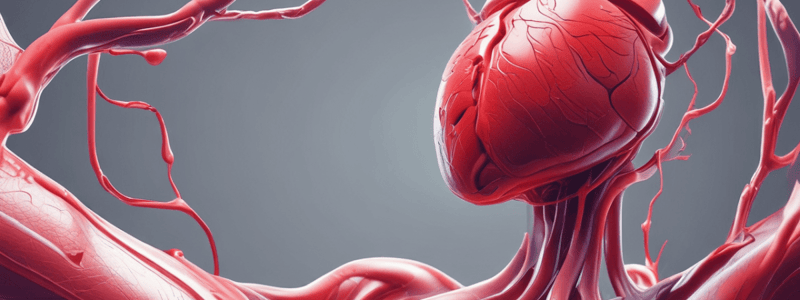Podcast
Questions and Answers
When you inhale, your ______ volume increases.
When you inhale, your ______ volume increases.
thoracic
Exhaling forcefully decreases the ______ of the thoracic cavity.
Exhaling forcefully decreases the ______ of the thoracic cavity.
volume
Inhalation and exhalation promote pulling of the blood from the ______ into the heart.
Inhalation and exhalation promote pulling of the blood from the ______ into the heart.
veins
Venous return decreases when blood ______.
Venous return decreases when blood ______.
People commonly ______ when they have to stand for a long time.
People commonly ______ when they have to stand for a long time.
Orthostatic hypotension is the temporary signal of low ______ volume.
Orthostatic hypotension is the temporary signal of low ______ volume.
A vein is made out of an outer wall of ______ tissue.
A vein is made out of an outer wall of ______ tissue.
A vein has less smooth muscle than an ______.
A vein has less smooth muscle than an ______.
The sympathetic nervous system can produce ______ of the veins.
The sympathetic nervous system can produce ______ of the veins.
Venous pressure increases when the ______ volume increases.
Venous pressure increases when the ______ volume increases.
Flashcards are hidden until you start studying
Study Notes
Blood Flow Regulation
- Reduced blood flow to one area redirects blood to another, typically from organs with lower metabolic needs, like the gut or kidneys.
- During heavy exercise, cardiac output can increase by up to five times to meet heightened metabolic demands.
Brain Blood Flow
- Blood flow is optimized within the brain; different regions receive varying levels of blood based on activity—engaging in studying redirects blood flow to relevant areas versus physical activity like running.
Mechanisms of Blood Vessel Regulation
- Vessel resistance is primarily determined by its diameter; constriction (vasoconstriction) increases resistance, reducing blood flow.
- Relaxation of smooth muscles leads to vasodilation, decreasing resistance and increasing blood flow.
- Venoconstriction limits the compliance of veins, elevating pressure and enhancing venous return to the heart.
Impact on Cardiac Function
- Increased venous return raises atrial pressure, translating to higher end-diastolic pressure, end-diastolic volume, and consequently, stroke volume and cardiac output.
- The overall effect results in a rise in mean arterial pressure (MAP).
Intrinsic vs. Extrinsic Regulation
- Extrinsic control mechanisms maintain mean arterial pressure, ensuring all organs receive adequate blood supply.
- Intrinsic control mechanisms govern blood distribution among organs and regulate flow based on metabolic needs—lower flow for low needs and higher flow for heightened demands.
Blood Flow Dynamics
- Blood flow to any organ is influenced by the pressure gradient and the resistance encountered within that organ.
- Mean arterial pressure generates equal driving pressure across organs; variations in blood flow arise due to differences in resistance.
- Organs can modulate blood flow by adjusting resistance, thereby increasing or decreasing their blood supply.
Studying That Suits You
Use AI to generate personalized quizzes and flashcards to suit your learning preferences.




